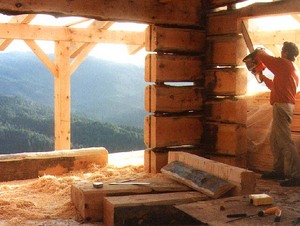The window sills in your home are typically the first window frame component to show the damage of rot. The window sill ends usually decay first due to the trapped water between the sill and the side frames of the window. In the most severe cases, the side jambs, trim and stops and the bottom corners of the window sash will also be affected by this problem. To fix this you can patch small holes, cracks and indentations with conventional wood filler. With the new latex fillers, they can provide good adhesion and weather resistance combined with the easy cleanup. When repairing larger areas, you may use polyester resin wood filler or a two-part epoxy wood filler. Keep in mind that if the window sill is split, rotted, or worn beyond repair, it would be best just to replace it.
To repair a rotted window sill
To start the repair, you will want to probe the decayed area with an awl or a screwdriver to see how far the rot in the window sill has extended to beyond the visibly damaged area. You need to also scrape off the loose or blistered paint around the damaged areas. The rot often will spread deeper into the wood than it will initially appear. If it seems that the damage is extensive or affects the parts of the sill that bear on the rough sill that is below or support the brick mold or casework, you will need to replace the window sill.
Next step is to scrape out the spongy or punky wood with a stiff putty knife or you may use wood chisel, either tool with work for this job. For the best possible results, you need to remove the material until you reach sound wood. If you want you can get away with removing only the loose material, putting into consideration that the material left in place is still in fair condition. By applying wood hardeners and sealing up the source of the moisture penetration will neutralize the spreading of the rot to the window sill.
Next, you need to drill one-fourth inch in diameter holes into the rotted area of the window sill to create a “tooth” for the wood filler product that will be applied. You will then apply liquid wood hardener to the wood surface that is in and around the repair area. Then scuff up any painted areas adjacent to the rotted section of the window sill. To do this you can use a piece of 150-grit sandpaper section to provide a better adhesion for the wood filler. You need to make sure the repair area is clean and as dry as possible before applying the filler. Next apply the wood filler by following the instructions on the products container label. Then press the filler firmly in place, roughly conforming it to the original shape of the damaged window sill. Smooth and shape the filled sections with a plastic putty knife, and do this while the filler is still soft for the best results. You will want to make sure not to strike off the filler past the plane of the adjoining wood surfaces.
After the wood filler has fully cured, you then can further shape the patch with a rasp or wood file. Both uses of these tools will remove the excess filler more quickly than sanding, and they will not burnish the surface like sanding can often do. Then clean the tools with a wire brush and solvent as soon as possible after you have finished using the tools.
Last step will be to hand-sand the finished profile onto the patch of the window sill with using a piece of 150-grit sandpaper section with a sanding block. Or if you rather use a medium-grit sanding sponge, that will work also. After that step is finished, immediately coat the repaired area with matching exterior paint, paint primer, or wood stain.
Then you have just finished making your window sill look good as new. Now you can sit back and enjoy the work you have done.




